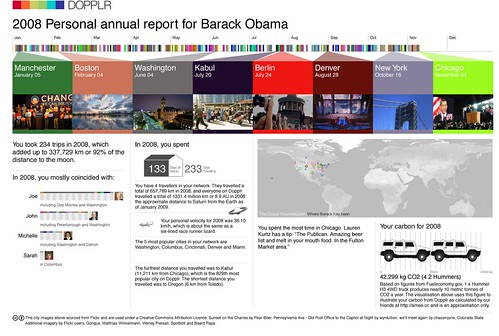By now, virtually every single blog in the world wide web has an analysis on president Obama's inaugural address posted on their cover. I wish I could be different, but it's kind of a hard thing to do when such an important event comes to pass. There are very few things republicans and democrats agree 100% on, but that the next few years are crucial to the United States continuation as the number 1 political power on the world is a given. Well, along with the rest of the so called "Americans" and despite their supreme self-centered way of thinking, here is one Brazilian who is hoping the next 4 years are remarkably successful for president Obama. Having that said, I thought I'd take this opportunity to post all the most interesting things I've seen on the various blogs, newspaper websites and whatnot in one big post. Brace yourselves, this is a whole lot of reading ahead... I hope you enjoy it as much as me.
The projects will not be posted in any particular order, not chronological, not preferential, neither any other category that might suggest any connection among them, so please, do read 'em all so that you don't miss anything.
I'll start up with one of the records of posting, Obama's portrait as a tag cloud.

This
project by
Jeff Clark @ Neoformix, was inspired by an image by
Gui Borchet. As a result, Jeff tweaked a few of his previews codes for
Word Hearts and
Clustered Words (which was Jeff's first attempt to build something similar to
Jonathan Feinberg's widely praised and in my opinion, the very best interpretation of the well known tag cloud ever made,
Wordle - also available on
Many Eyes), making his code able to color and size words to fit a pre-existing image. There is virtually very little information data analysis or information the user is able to retrieve from it, but it is on heck of an image. This is visualization art in it's purest form. Cuddles for Jeff!
Here is president Obama's inaugural address' generated image:
 Click here for original B&W portrait and here for original Inaugural Address image.
Click here for original B&W portrait and here for original Inaugural Address image.Here is Dopplr's visualization on 2008 Personal annual report for Barack Obama

As you can see, the man almost made it to the moon in 2008 (92% of the distance was covered) and spent almost twice as much time on the road then at home. Certainly showing commitment to his campaign. You can also see that Joe was with him most of the time and that John McCain was also present (even more than his wife Michelle - which reminds me of Chris Rocks'
jokes on "Kill the messenger", very funny!) but McCain's VP Sarah, well, just not that much...
As a counterpoint, for someone who praises Gore's environmental issues that much, his carbon footprint was equal to more than 4 Hummers. OK, for that much traveling, and keeping in mind that airplanes do pollute a lot more than any other thing in this world, I guess it was not that much in perspective to the benefits his election might bring to our world in that subject. By the way, just for kicks, here is what Lauren Kurtz has to say to Mr. President Barack: you gotta go to "The Publican. Amazing beer list and melt in your mouth food". I guess now he is elect, a couple cold ones wouldn't be that bad!
You can download Dopplr's original PDF here.I continue with one of the most interesting data correlation for the past year election, which I saw on
Flowing Data.

This post election analysis shows the correlation between cotton picking and voting. The relation is amazingly synchronized. As
Strange Maps does point out, this doesn't mean that by increasing the cotton plantations on other parts of the country would increase the number of democrats, but it does show that due to heavy migration of African Americans to those regions caused by the cotton industry, those counties had a significant majority of voters for Obama (91% of the African Americans population voted for Obama). This is a great correlation - not causation - example and a very interesting read.
This next piece, by OPEN N.Y., shows the correlation between height and weight in the presidency history dating back to 1896.

In this graph, it's clear that the seemingly more robust body has had an edge on presidential elections since the 25th president. Makes sense, since the people would rather have a leader they find fit. Yes, I know, fat is not fit! But remember that not that many years back, this fitness race of our time was not present and fatness did actually mean wealthier and healthier - which are strong qualities for someone we expect to run our country for the next years. Barack's win only confirmed this pattern, beating McCain's short and curved,
Ephialtes-like figure.
You can find the original article
here.
Next is Washington Post's post on tax proposals for both candidates.

As you can easily see, the main difference is that Obama's proposal was to increase the taxes by 5% of all those filthy rich multi-millionaire people we all love to hate and to wish were us while decreasing taxes for the bottom end of the financial pyramid while McCain's proposal was to lower taxes for everybody! Borrowing Phoebe's half brother Frank line on Friends: "No no no, this is a new plan! Three kids and no money!!!". Not quite getting what I meant? look at the bottom line: Obama's proposal equals virtually no change on the final tax amount while better organizing tax expense for the population. McCain's proposal equals more than a thousand dollars average in tax income while continuing to favor those in the big chairs! Not a mystery why Obama won the election. The least favored group by McCain's proposal meant 60% of votes, I mean, at least check your numbers Mr. McCain!
And for the Pièce de résistance, among so many others, here is Many Eyes' tag cloud of the inaugural address:
If you can't see this visualization, click here to see the original)As you can see in this two-word tag cloud, this is indeed a new age, designed to be filled with the care for health, economy and hard work, with the lack of war and fights (hopefully!). It could not have come too soon! Let the new times begin!
Good luck Mr. President. Know that our hearts and minds are with you and we are more ready work hard and be lead back to the right side of things!
Let the good times roll!
 Del.iciou.us
Del.iciou.us














































